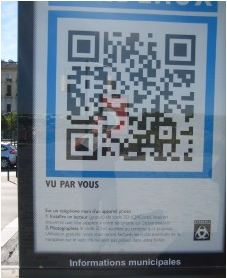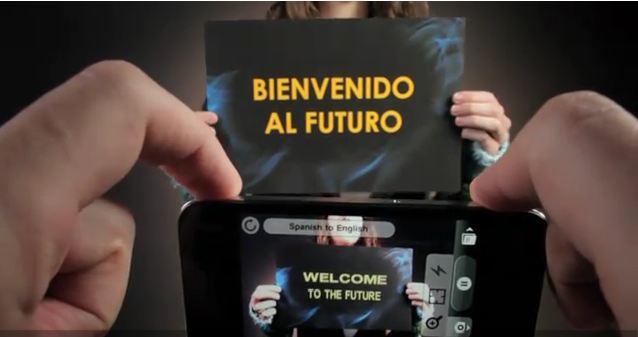AUGMENTED CPG
Shared links from Augmented CPG
April 13, 2012
March 14, 2012
Oasis Soccer, Our last baby is well received!
Check out our last Augmented Reality game at oasissoccer.com!
 Here is the list our article talking about this game:
Here is the list our article talking about this game:
Strategy Online:
http://strategyonline.ca/2012/03/13/oasis-techs-out-its-tetra-paks/
Itbusiness:
http://www.itbusiness.ca/it/client/en/home/News.asp?id=66502&PageMem=2
 Here is the list our article talking about this game:
Here is the list our article talking about this game:Strategy Online:
http://strategyonline.ca/2012/03/13/oasis-techs-out-its-tetra-paks/
Itbusiness:
http://www.itbusiness.ca/it/client/en/home/News.asp?id=66502&PageMem=2
February 01, 2011
Will Augmented Reality Leap-Frog the QR Code?
There continues to be a steady buzz about QR codes, those bar code-looking thingys that can be scanned by a smart phone to link you to added content, a website or perhaps even a coupon at the point of purchase. Here’s the Wikipedia definition.
I’m not an expert in QR codes – or anything for that matter — but I’ve been around long enough to have a good idea if something is going to work or not. I’m thinking the buzz on QR codes may be short-lived – and I’d like to explain why by telling you a short story about a beer can.
One of my most interesting jobs was global marketing director for aluminum packaging products (like beverage cans). While this may sound mundane, the opportunity to nurture $2.5 billion in sales with some of the world’s biggest brands was a lot of fun!
On a customer trip, I noticed the flight attendant had a lanyard around her neck with a strange plastic device on the end. The device served as a fulcrum that she used under the tabs to open each can. I asked her why she just didn’t open the pop-tops with her fingers and she pointed to her well-manicured nails.
I suddenly realized that our humble package had a big problem. A significant part of the population — people with manicured nails — needed a secondary device to open the package. We were vulnerable! Any competing package that did not require a secondary “opener” (like plastic bottles) would be preferred by these consumers!
This revelation led to an R&D project aimed at an easier-opening lid which included a depressed “well” under the tab to protect well-groomed nails.
QR codes are vulnerable in the same way — you need an “opener” to get to the goods. Consumers will resist this, especially if there is an alternative — and there is.
 Last summer I was in Bordeaux and noticed they had QR code posters everywhere to provide information on city events. I was a tourist with money to spend — their target market — but I couldn’t use the system. Problem 1: The instructions were in French. Problem 2: You had to download special software to access the information. Problem 3: As an international visitor, I would have to access expensive roaming charges just to get the code.
Last summer I was in Bordeaux and noticed they had QR code posters everywhere to provide information on city events. I was a tourist with money to spend — their target market — but I couldn’t use the system. Problem 1: The instructions were in French. Problem 2: You had to download special software to access the information. Problem 3: As an international visitor, I would have to access expensive roaming charges just to get the code.The “opener” in this case was a significant obstacle. If the city went to the trouble of creating posters, why not put up one up that simply had the information people needed? Why make me WORK for it?
Now suppose such a helpful poster existed … you would still have the problem of a language barrier, right? The problem could easily be solved for anybody that had a free smartphone app called WordLens. This technology is part of a swelling trend called augmented reality that I think will leap-frog the QR code innovation.
In this example, by simply holding the phone in front of the foreign language, you get an instantaneous translation and access to the information when you need it, where you need it. No instructions. No dependence on an Internet connection. No expenditure in time or expense. It’s just an extraordinarily user-friendly experience.
I don’t think you can question the power of the idea behind QR Codes but I have reservations about customer adoption. I believe augmented reality is one of the seminal technologies of 2011 and a development that could obsolete QR codes in many cases. Imagine holding your phone up in front of a city street and having discounts, movie times, even names of nearby friends overlayed on top of the buildings? Or using the phone to scan a display of shirts to immediately find your size, discounts, and matching pants and accessories?
There will probably be legitimate uses for QR codes, especially for industrial applications and logistics tracking, but I believe augmented reality may leap-frog the innovation in the consumer arena before it leaves the gate. This is just one opinion and I’m sincerely open for debate here — what’s your take on it?
About the author:
Executive Director Mark Schaefer has 28 years of global sales and marketing experience and advanced degrees in business and applied behavioral sciences. He is an award-winning business writer, university lecturer and innovator, receiving seven international patents for new product ideas with Fortune 100 companies. He teaches at Pellissippi State College in Knoxville and serves as an adjunct professor of marketing at Rutgers University.
January 28, 2011
The Rolling Stone on augmented reality
AugmentReality.co.uk – Augmented Reality Browser: Layar
Here is an exemple of augmented reality application for mobile using Layar, using successfully a integration with facebook.
Quiznos - Augmented reality with Layar
Brands – Augmented Reality Browser: Layar
The Quiznos layer includes a store locator, several videos, animated 3D and location based coupons.
The Quiznos layer includes a store locator, several videos, animated 3D and location based coupons.
January 27, 2011
THE FACTS: Canada's fearsome growth, and power
Quebec alone has 5,000 developers, 600% growth since 2003, and 2,000 computer science graduates a year
The Canadian province of Quebec is one of the fastest-growing game development clusters in the world, but how did it become so?
With the help of data supplied by Investment Quebec, Develop has scoured the key facts of Quebec’s widely-envied and relentlessly expanding dev scene.
One of the key lessons to be learnt from the new data is how well tied its academic institutions are with local game studios – a lesson Develop will return to next week with the Livingstone-Hope Skills Review.
Scroll down to find statistics on workforce, job creation, education, expenses and tax breaks.
The figures are revealed days after Tiga warned the UK's workforce could fall below 7000 by 2015 witout game tax breaks. If realised, that would give the UK a smaller workforce than the Quebec region alone.
JOBS & WORKFORCE
Quebec’s game development workforce has grown by 600% since 2003.
The core of the industry is formed by about 50 DEVELOPMENT STUDIOS that provide work for 5,000 people.
The region’s wider entertainment industry encompasses more than 80 COMPANIES INVOLVED IN GAMES development, publishing, production services, software and middleware.
In total, these companies EMPLOY 7,000 PEOPLE and generate many other jobs indirectly.
DEVELOPMENT COSTS & TAX BREAKS
Depending on certain criteria being met, games produced in Quebec can be given a TAX BREAK REDUCTION OF 37.5% OF LABOUR COSTS.
On average, Quebec studio operating costs are AT LEAST 20% LOWER than in the United States, nearly 24% lower than in Europe and nearly 30% lower than in Japan.
EDUCATION
Quebec has over 5,000 university students GRADUATE IN COMPUTER SCIENCE and multimedia‑related fields every year.
In 2008, the number of computer science graduates, in Quebec alone, stood at 2,852
Quebec is home to world‑renowned private schools including:
National Animation and Design Centre
National Institute of Digital Entertainment
National Audio‑Visual Institute
SOURCE:http://www.develop-online.net/news/36870/THE-FACTS-Canadas-fearsome-growth-and-power
The Canadian province of Quebec is one of the fastest-growing game development clusters in the world, but how did it become so?
With the help of data supplied by Investment Quebec, Develop has scoured the key facts of Quebec’s widely-envied and relentlessly expanding dev scene.
One of the key lessons to be learnt from the new data is how well tied its academic institutions are with local game studios – a lesson Develop will return to next week with the Livingstone-Hope Skills Review.
Scroll down to find statistics on workforce, job creation, education, expenses and tax breaks.
The figures are revealed days after Tiga warned the UK's workforce could fall below 7000 by 2015 witout game tax breaks. If realised, that would give the UK a smaller workforce than the Quebec region alone.
JOBS & WORKFORCE
Quebec’s game development workforce has grown by 600% since 2003.
The core of the industry is formed by about 50 DEVELOPMENT STUDIOS that provide work for 5,000 people.
The region’s wider entertainment industry encompasses more than 80 COMPANIES INVOLVED IN GAMES development, publishing, production services, software and middleware.
In total, these companies EMPLOY 7,000 PEOPLE and generate many other jobs indirectly.
DEVELOPMENT COSTS & TAX BREAKS
Depending on certain criteria being met, games produced in Quebec can be given a TAX BREAK REDUCTION OF 37.5% OF LABOUR COSTS.
On average, Quebec studio operating costs are AT LEAST 20% LOWER than in the United States, nearly 24% lower than in Europe and nearly 30% lower than in Japan.
EDUCATION
Quebec has over 5,000 university students GRADUATE IN COMPUTER SCIENCE and multimedia‑related fields every year.
In 2008, the number of computer science graduates, in Quebec alone, stood at 2,852
Quebec is home to world‑renowned private schools including:
National Animation and Design Centre
National Institute of Digital Entertainment
National Audio‑Visual Institute
SOURCE:http://www.develop-online.net/news/36870/THE-FACTS-Canadas-fearsome-growth-and-power
January 26, 2011
WELCOME
Here is a collection of various elements showcasing uses of the Augmented Reality, the related innovations and of market data related to it.
It also shows the latest associations between Augmented reality and Game consoles.
Access various subjects via the tabs above.
It also shows the latest associations between Augmented reality and Game consoles.
Access various subjects via the tabs above.
Subscribe to:
Posts (Atom)
.JPG)

